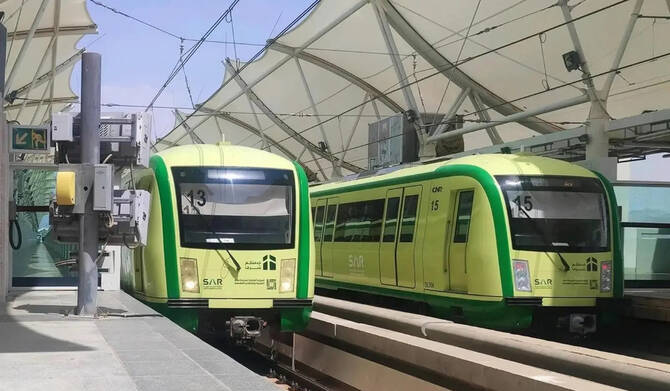Hajj Metro 2025 is getting ready for its busiest week of the year. Over just seven days, the metro system will complete 4,900 train journeys and help transport around 2 million pilgrims between the holy sites of Mina, Arafat, and Muzdalifah.
The metro, officially known as the Al-Mashaaer Al-Mugaddassah Metro, is designed to make the sacred journey of Hajj easier, safer, and faster for Muslims from all over the world.
What Is the Hajj Metro?
The Hajj Metro is a special train service built only for the annual pilgrimage. It connects three key sites that Muslims must visit during Hajj: Mina, Arafat, and Muzdalifah. The entire route stretches over 18 kilometers and includes nine stations. Trains run frequently during the Hajj days to manage the huge number of people.

Each train has 12 cars and can carry up to 3,000 people. These trains are fast, reliable, and air-conditioned, offering much-needed comfort during the hot Saudi summer.
How the Metro Works During Hajj
During the 2025 Hajj season, the Hajj Metro will be in action for seven days straight. Every day, it will complete hundreds of trips to ensure pilgrims move on time between their required stops. That means around 700 journeys each day—a massive operation managed with military-level precision.

To reduce waiting time, trains are scheduled to arrive every 2 to 3 minutes at peak hours. Trained staff, volunteers, and modern technology are used to keep everything running smoothly.
Why the Metro Is So Important
Moving two million people is not easy—especially in extreme heat, with many people elderly or traveling with families. Before the Hajj Metro, buses and cars used to crowd the roads, causing delays and increasing the risk of accidents.
With the metro:
- Pilgrims can travel quickly and safely
- Traffic jams are reduced
- People spend less time walking long distances in the heat
- There is less pressure on emergency services
It’s not just about convenience—it’s about saving lives and making Hajj more accessible to all.
Who Will Use the Metro in 2025?

The metro is designed to carry up to 72,000 people every hour in one direction. In 2025, it is expected that:
- Around 2 million pilgrims will use the metro
- Most will travel during the three busiest days of Hajj
- People from over 100 countries will be part of the crowd
Special arrangements are made for elderly pilgrims, people with disabilities, and those traveling with young children to ensure comfort and accessibility.
Preparing the Metro for the Rush
Every year, the metro system goes through strict checks before Hajj begins. Trains are cleaned, tested, and fully maintained. Staff are given safety training, and simulation drills are run to prepare for emergencies.
In 2025, new improvements have been added, including:
- Better air-conditioning in carriages
- Improved digital signage in multiple languages
- Smart entry systems to reduce crowding at stations
There are also more volunteers and guides on hand to help non-Arabic speakers and first-time visitors.
How the Metro Connects to the Bigger Hajj Transport Plan
The Hajj Metro is just one part of Saudi Arabia’s large-scale transport network designed for the pilgrimage. To handle the millions of visitors, the country is also using:
- High-speed trains between major cities like Makkah and Madinah
- Buses operating on updated road networks
- New airports and terminals made just for Hajj travelers
These systems work together like clockwork to make sure people arrive on time for every ritual.
Smart Technology Supporting the Hajj Metro
In 2025, the metro system is even smarter. New technologies are being used to monitor crowd sizes and predict where more support is needed. Cameras, sensors, and AI systems help:
- Track the flow of passengers
- Prevent overcrowding at stations
- Alert staff to emergencies quickly
This use of smart tech helps improve safety, speed, and service for every pilgrim using the metro.
Health and Safety for Pilgrims on the Metro

With millions of people moving together, health and safety are a top concern. The Hajj Metro team has taken many steps to protect passengers:
- All trains are deep cleaned multiple times daily
- Medical staff and emergency response teams are present at every major station
- Cooling zones and hydration points are set up to fight heat exhaustion
- Digital screens share health alerts in real time
Special teams are also available to assist in case of medical emergencies inside the metro stations or trains.
How the Hajj Metro Fits into Saudi Arabia’s Future
The Hajj Metro is part of a much larger plan called Saudi Vision 2030. The goal is to make pilgrimage safer, smoother, and more inclusive, and to handle growing numbers of visitors every year.
The Hajj Metro has:
- Reduced traffic and pollution
- Helped older and disabled pilgrims move safely
- Created hundreds of jobs in operations and services
Future plans may include expanding the metro route, increasing the train fleet, and adding more stations.
A Modern Solution for an Ancient Journey
The pilgrimage of Hajj has taken place for centuries, and millions of Muslims still make the sacred trip every year. The Hajj Metro shows how modern solutions can support traditional practices. By using smart planning, fast trains, and caring staff, Saudi Arabia has made it easier for pilgrims to focus on their spiritual journey—not their travel stress.
With 4,900 journeys in just one week, the Hajj Metro 2025 is ready to move 2 million people—efficiently, safely, and with dignity.
Read More: NABNI and Hilton Unveil Stunning Waldorf Astoria Residences Dubai














